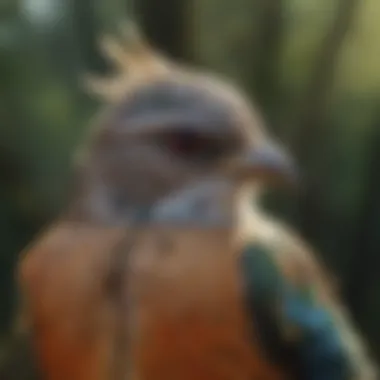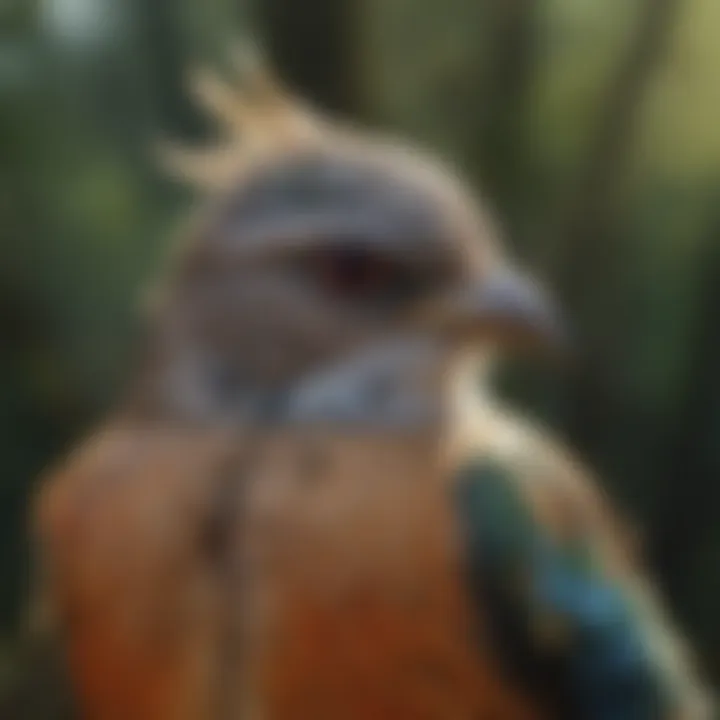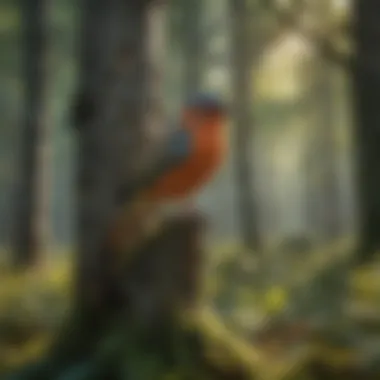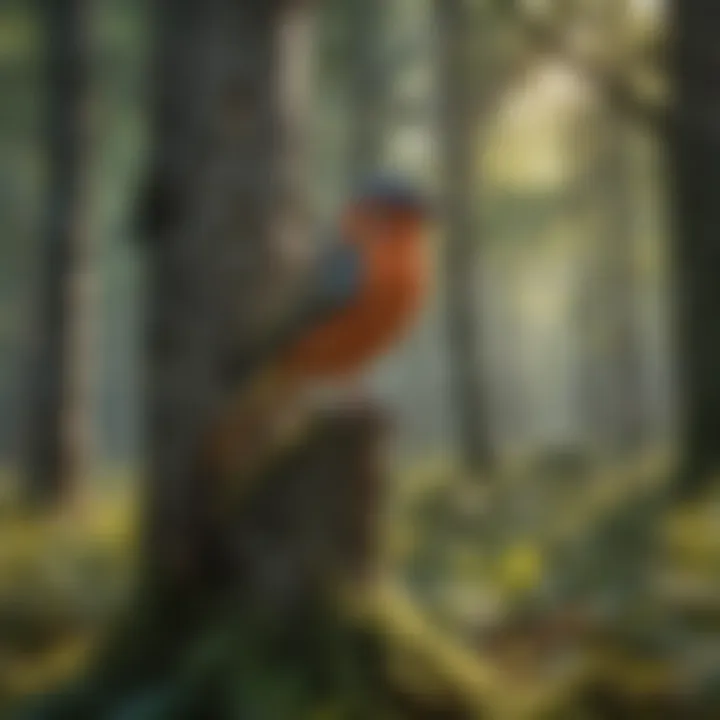Exploring Avian Diversity: A Detailed Guide to Bird Species


Intro
Avian diversity fascinates countless enthusiasts and experts alike. Birds, with their range of colors, sizes, and behaviors, provide an enriching lens to understand the intricate interplay of life in woodland ecosystems. This article aims to be a compass guiding readers through this vibrant world, offering insights into diverse bird species categorized by their habitats and ecological roles.
The discussion will venture into different aspects of birds, revealing not only their physical characteristics but also their behaviors and contributions to forest ecosystems. Understanding these elements is essential, especially for forestry professionals and academics who study woodland environments.
Understanding Woodland Ecosystems
Woodland ecosystems are not just mere collections of trees; they form a complex network of life where every species plays a part. These environments provide vital support for myriad bird species, each carving out a niche in the lush tapestry of flora and fauna.
Importance of Biodiversity in Forests
Biodiversity in forests instills resilience, allowing ecosystems to withstand disturbances such as invasive species and climate change. Here are a few points on why this diversity matters:
- Habitat Variety: Different bird species prefer varied habitats which support their specific needs. This variability results in a rich tapestry of life within woodlands.
- Pollination & Seed Dispersal: Birds historically play a crucial role in forest regeneration. Many plant species rely on birds for pollination and seed dispersal.
- Natural Pest Control: Birds help manage insect populations, thus maintaining the health of forest ecosystems.
The loss of any bird species can reverberate through the ecosystem, disrupting these critical functions and stunting the ecological balance.
Role of Forests in Climate Regulation
Forests act as significant carbon sinks, absorbing carbon dioxide from the atmosphere, making them integral in climate regulation. They help moderate temperatures and maintain water cycles. Birds contribute to this mechanism by influencing various ecological processes, including nutrient cycling and energy flow.
"Healthy forests mean healthy birds, and healthy birds are essential for a balanced ecosystem."
Sustainable Forestry Practices
To preserve avian diversity, sustainable forestry practices are paramount. They ensure that our woodlands not only thrive but continue to support various species today and into the future.
Principles of Sustainable Forestry
Sustainable forestry practices encompass several principles:
- Selective Logging: Rather than clear-cutting, which devastates habitats, selectively harvesting trees protects the overall ecosystem.
- Preserving Bird Habitats: Designing forestry operations that minimize disturbances to nesting and feeding sites.
- Continuous Monitoring: Regular assessments to adapt management strategies can further sustain bird populations and their habitats.
Case Studies of Successful Implementations
One notable success is the Sustainable Forestry Initiative, which has created certified forests in North America. These forests strike a balance between timber production and ecological preservation. Additionally, various national parks have adopted similar practices, ensuring that their rich avian life continues to flourish.
Woodland Stewardship Techniques
Understanding how to manage forest resources responsibly nurtures the environment and supports vibrant bird populations. Effective stewardship techniques foster an environment where both trees and birds can thrive together.
Forest Management Plans
A forest management plan should include strategies for:
- Enhancing Habitat Quality: Ensuring that different bird species have suitable conditions to thrive.
- Promoting Native Species: Planting native species encourages biodiversity and supports local wildlife including birds.
Conservation Strategies
Implementing strategies focused on protecting bird populations is crucial:
- Monitoring Bird Populations: Tracking populations provides insight into how different forestry practices affect avian species.
- Creating Protected Areas: Conservation areas serve as sanctuaries, allowing species to flourish without human interference.
In the end, recognizing the interconnectedness of woodland health and avian diversity is vital for informed decision-making. By respecting and understanding our feathered friends, we can foster healthier ecosystems that benefit all species.
For further reading, check out resources like Wikipedia and Britannica for expansive insights into various bird species and their ecological importance.
Understanding Bird Diversity
Bird diversity encompasses the vast range of species that exist across various habitats and ecosystems. This section highlights essential facets regarding why understanding the richness of bird species is paramount in the larger context of environmental health and conservation efforts.
Importance of Avian Diversity
Avian diversity plays a crucial role in maintaining ecological balance. Birds contribute to several vital functions within ecosystems, such as:
- Pollination: Some bird species, notably hummingbirds, engage in pollinating flowers, thereby supporting plant reproduction.
- Seed Dispersal: Many birds consume fruits and subsequently spread seeds through their droppings, promoting forest regeneration.
- Pest Control: Predatory birds help manage insect populations, which can prevent crop damage.
An ecosystem rich in bird variety is typically more resilient. This resilience can offer protection against environmental changes, ensuring that various ecological niches are filled and maintained. Without sufficient bird diversity, habitats may suffer from imbalance, leading to overpopulation of pests or decline in plant species that depend on specific bird interactions.
"A balanced ecosystem is like a well-tuned orchestra, where each species plays its distinctive part."
Factors Influencing Bird Classification
Bird classification hinges on several criteria, which allow ornithologists and ecologists to make sense of the immense diversity found within avian species. Some of the primary factors include:
- Morphology: Physical traits such as size, color, and beak shape are fundamental elements in distinguishing various bird species.
- Genetic Data: Advances in genetic sequencing have provided novel insights into evolutionary lineages, refining our understanding of how different species are related.
- Behavioral Traits: Mating rituals, vocalizations, and feeding habits are observable characteristics that often dictate classification.
- Geographical Distribution: The habitats where birds reside can significantly influence their classification, as species often adapt uniquely to their environment.
In summary, understanding these classification factors not only enriches our knowledge of bird species but also aids in conservation efforts, as it allows researchers to predict how changes in the environment might impact specific avifauna.
Broad Categories of Bird Species
Understanding the broad categories of bird species is fundamental in appreciating avian diversity and its significance in our ecosystems. Birds can be broadly divided into two major categories: passerine and non-passerine. This classification not only helps in identifying birds but also provides insight into their behavior, habitats, and evolutionary history. Recognizing these categories benefits professionals and enthusiasts alike by offering a robust framework through which to study and appreciate these remarkable creatures.
Passerine Birds
Passerine birds, known as the songbirds, represent the largest order of birds, comprising more than half of all known species. They are distinguished by their unique vocalizations and perching behavior. Common examples include sparrows, finches, and warblers. The vast diversity within this category serves many ecological roles across a wide range of habitats.
The adaptability of passerine birds to different environments is notable. They inhabit woodlands, grasslands, and urban areas, often exhibiting behaviors that allow them to thrive in changing conditions. For instance, the house sparrow has made its home in human settlements around the world, highlighting its resilience.
Passerines possess several unique features:
- Vocal Complexity: Their ability to produce a wide variety of sounds plays a crucial role in communication, territory establishment, and mate attraction.
- Feet Adaptations: Designed primarily for perching, their feet allow for grasping branches and holding onto complex structures.
- Diverse Diets: Ranging from seeds to insects, their nutritional preferences help control insect populations and contribute to plant reproduction.
With their colorful plumage and lively songs, passerines not only enrich our natural landscapes but also signal ecological health. Their presence—or absence—can indicate the state of the environment, making them vital bioindicators. This makes studying passerines crucial for both conservation efforts and enhancing our understanding of ecosystem dynamics.
Non-Passerine Birds
Non-passerine birds encompass a wide variety of species that do not fall under the passerine category. This group includes larger birds, such as raptors (like eagles and hawks), waterfowl (ducks and swans), and flightless birds (like ostriches and emus). Each of these birds showcases distinct adaptations suited to their lifestyles and environments.
Typically, non-passerines are characterized by their different approaches to feeding, nesting, and social behaviors compared to their passerine cousins.
For example:
- Raptors generally have exceptional eyesight and powerful talons for hunting, making them apex predators in their ecosystems. They play critical roles in controlling prey populations, which in turn helps maintain ecological balance.
- Waterfowl, on the other hand, exhibit unique adaptations for aquatic life, like webbed feet and specialized bills for filtering food from water. Their migratory patterns are also remarkable, with some species traveling thousands of miles between breeding and wintering grounds.
- Flightless birds hold a unique evolutionary path, often due to isolation on islands or specific environmental pressures. Their adaptations might include heavier bodies and reduced wing size, leading to fascinating evolutionary discussions around their ancestral origins.
The diversity found within non-passerine birds illustrates the vast array of ecological roles they play. From keeping insect populations in check to participating in nutrient cycling across ecosystems, these birds' contributions are significant.
"The variety of birds around us serves as a mirror reflecting the health of our ecosystems; the more diverse the feathers, the more balanced the natural harmony."
In summary, exploring the broad categories of bird species offers a window into the ecological intricacies of our world. Understanding passerine and non-passerine birds fosters greater appreciation for avian diversity, encourages sustainable conservation efforts, and highlights the critical role these species play in maintaining ecosystem balance.


Birds by Habitat
Understanding how birds adapt to different habitats is crucial in ornithology. The diverse environments where birds thrive—such as forests, wetlands, grasslands, and urban areas—provide unique opportunities and challenges. Each habitat presents its own set of resources, such as food, shelter, and nesting sites, that influence bird species' behaviors and adaptations. Consequently, studying birds by habitat not only enhances our appreciation of their biodiversity but also helps in conservation efforts.
Forest Birds
Forest birds, like the vibrant Scarlet Tanager or the elusive Northern Spotted Owl, showcase remarkable adaptations to life among trees. Dense canopies provide shelter, while rich undergrowth supplies food through insects, seeds, and fruits. Forests are vital ecosystems, and birds play numerous roles within them—acting as pollinators, seed dispersers, and natural pest control agents.
For instance, woodpeckers create cavities that serve as nesting sites for various species, including themselves. The competition for these desirable locations can lead to fascinating dynamics among avian species. Additionally, forest birds often exhibit unique vocalizations that serve functions ranging from mating calls to territorial disputes.
Wetland Birds
Wetland areas—comprising marshes, swamps, and estuaries—are key to avian diversity. Birds like the Great Blue Heron and the American Bittern rely on these rich ecosystems for their survival. These environments act as natural filters for water while providing crucial habitats for numerous species.
Wetland birds often have specialized feeding strategies, adapted to their aquatic surroundings. For example, herons utilize their sharp beaks to spear fish, while ducks dabble for vegetation. Furthermore, these areas support high levels of biodiversity, making them essential for both migratory and resident birds. Protecting wetlands not only helps sustain bird populations but also maintains the ecological balance.
Grassland Birds
Grassland habitats, characterized by open fields and prairies, are home to species like the Meadowlark and the Bobolink. These birds often have ground-nesting habits, camouflaged by the tall grasses that provide both protection and food sources. Unlike forest or wetland birds, grassland birds rely heavily on the abundance of seeds and insects found in open areas.
The decline of grassland habitats due to agricultural expansion poses significant threats to these species. Conservationists focus on protecting grasslands by promoting sustainable farming practices and restoring native vegetation. Understanding the unique behaviors and needs of grassland birds is key to preserving these vital ecosystems.
Urban Birds
Urban environments, although highly modified, are increasingly important habitats for many bird species. Birds like the Rock Pigeon and the House Sparrow have adapted exceptionally well to city life, exploiting the resources available in human-dominated landscapes. These opportunistic feeders can find food waste, nesting materials, and shelter in buildings and parks.
Interestingly, urban birds often exhibit different behaviors compared to their rural counterparts. For instance, they may rely more on vocalizations to communicate over the sounds of urban noise. This adaptability showcases the resilience of bird species in the face of rapid environmental changes.
The ability of birds to adapt to various habitats is a testament to their resilience and ecological significance.
In summary, examining birds by habitat reveals rich ecological stories and highlights the importance of habitat preservation for avian diversity. Each habitat serves as a tapestry of interactions that creates a sustainable environment for birds and other wildlife. Conservation efforts must consider these diverse needs to ensure the survival of multiple bird species across the globe.
Birds and Their Ecological Roles
Birds play multifaceted roles within ecosystems, influencing various processes that maintain ecological balance. Their significance is often overlooked, yet it permeates through every aspect of the environment. In this section, we explore key contributions of birds, including their roles as pollinators, seed dispersers, and predators. Understanding these roles enhances our appreciation of birds and underscores the importance of their conservation in maintaining biodiversity and healthy ecosystems.
Pollinators
Pollination is vital for flowering plants to reproduce, and yet, it is not just the bees that do the heavy lifting. Birds, particularly hummingbirds and certain species of honeycreepers, are crucial players in this process. Their long bills and specialized feeding habits allow them to access nectar in deep flowers, which many insects can't reach. As they flit from bloom to bloom, they transfer pollen, fostering genetic diversity in plants.
- Hummingbirds are particularly noteworthy. They are not just attracted to bright flowers; the structure of these plants often coevolved specifically for them, ensuring a mutual benefit.
- On the other hand, the sugarbird species in southern Africa also engage in similar relationships, pollinating species like the Protea, which relies heavily on them for reproduction.
Interestingly, the loss of these birds could lead to a decline in specific plant species, ultimately affecting entire habitats that depend on those plants. As various regions face habitat alteration, the necessity to protect these bird populations has never been so crucial.
"Without birds, many plants could face severe declines. Their intertwined fates remind us of the delicate balance of our ecosystems."
Seed Dispersers
Birds are also key players in seed dispersal, which is essential for plant reproduction and genotype mixing. Several bird species consume fruits and berries, later excreting the seeds far from the parent plant. This movement promotes forest regeneration and helps maintain healthy populations of various plant species.
For instance, the American Robin is known for its affinity for berries. As these robins feast, they scatter the seeds across expansive areas, allowing plants like Holly and Blueberry to thrive in new locations. Similarly, the Cassowary in tropical rainforests plays an equally significant role; it consumes fruits and its unique digestive tract aids in the germination of many rainforest plants, including the Ephedra, which relies solely on this bird for survival.
The benefits of seed dispersal include:
- Promoting genetic diversity among plant populations
- Enabling colonization of new habitats
- Maintaining healthy ecosystems by providing food and shelter for diverse wildlife
Predators and Their Impact
Birds sit atop various food chains and play a critical role in maintaining ecological balance as predators. Species such as hawks, owls, and falcons control the population of small mammals and insects, which in turn can prevent overpopulation and the resultant destruction of vegetation.
Consider the Peregrine Falcon, renowned for its stunning aerial abilities. This bird primarily hunts pigeons and other similar-sized birds. By keeping these populations in check, it allows for the stability of the ecosystem, ensuring that no single species dominates.
- Owls, with their nocturnal hunting habits, serve a crucial role in controlling rodent populations. A barn owl can consume upwards of 1,000 rodents in a year, significantly influencing the population dynamics of their prey.
- Lastly, birds of prey may also aid in scavenging behaviors, cleaning the environment of carrion and thus reducing the spread of disease.
In sum, the ecological roles of birds are vital for the health of ecosystems. Their contributions, whether through pollination, seed dispersal, or predation, highlight the interdependence of species and the delicate threads that weave the fabric of environmental health. Without proper attention to the threats birds face, we risk unraveling these connections.
Behavioral Classifications of Birds
Delving into the behavioral classifications of birds provides a unique lens through which we can understand avian life. The patterns that birds exhibit in their daily activities, from migrating thousands of miles to courting their mates, offer insights into their adaptability and survival strategies. Understanding these behavioral traits is essential not only for ornithologists but also for forestry professionals and conservationists. By studying these classifications, we gain valuable knowledge that the maintains balance in ecosystems and informs efforts in bird conservation.
Migratory Patterns
Bird migration is one of nature's most fascinating phenomena. Many species travel across continents and oceans, covering vast distances to find suitable breeding and feeding grounds. This journey is often dictated by climatic conditions and resource availability.
- Types of Migration: Birds can typically be categorized into three main types:
- Latitudinal migration: Moving north and south with the changing seasons.
- Altitudinal migration: Shifting to higher or lower elevations depending on season.
- Nomadic migration: Moving in response to food scarcity or environmental changes.
The American Robin and the Arctic Tern are prime examples of migratory birds. While the robin travels south to escape the cold of winter, the Arctic Tern undertakes one of the longest migrations known, traveling between its breeding grounds in the Arctic and wintering areas in the Antarctic, showcasing incredible navigational skills.
Understanding these migratory patterns can aid in habitat conservation efforts, ensuring that critical stopover sites are preserved for these birds during their journeys, thus maintaining the rhythm of nature.
Courtship Displays
Courtship is another key behavior seen in many bird species, and it offers a glimpse into their complex social interactions. These displays often serve a dual purpose: attracting a mate and establishing territory. Rich in variety, courtship strategies can involve:
- Vocalizations: Unique calls or songs that convey fitness and readiness to mate.
- Visual Displays: Feather fluffing, elaborate dances, and striking plumage colors all signal health and genetic strength.
- Nest Building: Some species engage in nest decoration where males collect bright materials to entice females.
The Peacock's tail, for instance, illustrates the extravagant lengths to which birds will go in showcasing their vitality and genetic health. The more spectacular the display, the more likely they are to attract a mate. This behavior is not just fascinating but critical for the continuation of the species. They are also indicators of environmental health, reflecting how conditions can affect reproduction and survival.
Feeding Strategies
Feeding strategies of birds vary widely and adapt to their ecological niches. Behaviors can be classified into several unique tactics based on what and how they eat. Notable strategies include:
- Foraging Techniques: Birds like the California scrub jay exhibit intelligence by hiding food for later. In contrast, the Hummingbird employs a technique called nectar robbing, extracting nectar from flowers, often without pollinating them.
- Social Feeding: Certain bird species, such as the European Starling, exhibit flocking behavior to scour for food, benefiting from safety in numbers. This practice enhances their chances of survival against predators while maximizing feeding efficiency.
- Tool Use: Crows and certain parrots are known for their ability to use tools, showcasing advanced cognitive skills. They have been seen using sticks to extract insects from crevices.
In summary, examining bird feeding strategies significantly enriches our knowledge of their roles within ecosystems. By understanding how different species find and utilize food sources, we can better appreciate the intricate web of life in which they play a part.
Understanding bird behavior is not just about fascination; it is a vital component in efforts to sustain avian populations in the face of environmental changes.
Common Birds in Woodlands
Woodlands are crucial ecosystems that support a vibrant array of life, including a diverse assortment of bird species. The presence of common birds in these areas is indicative of ecological health, providing insight into the state of the environment. These birds contribute significantly to the balance of nature through their roles in pollination, pest control, and seed dispersal. For forestry professionals and academics, understanding the behaviors and characteristics of these birds can enhance conservation efforts and promote biodiversity. Furthermore, these birds serve as both cultural icons and subjects of scientific inquiry, enriching our appreciation of natural landscapes.
Sparrows
Sparrows are small, adaptable birds often found flitting around the underbrush of woodlands. The house sparrow, Passer domesticus, is perhaps the most recognized species, known for its bold behavior and ability to thrive in close proximity to humans. However, it’s the native sparrows, like the white-throated sparrow, which reflect the health of woodland habitats. In contrast to their more urban cousins, these woodland sparrows primarily feed on seeds, insects, and berries, playing a vital role in controlling insect populations and dispersing plant seeds.
Observing sparrows can also give researchers clues about habitat changes. Their habitat preferences often reflect the availability of food and nesting sites. Monitoring their populations aids in understanding broader ecological dynamics. Careful observation and documentation of sparrow activity can yield insights into the impacts of environmental stressors.
Woodpeckers


Woodpeckers are fascinating avian architect, often easily spotted by their distinctive pecking sounds echoing through the forests. Species like the downy woodpecker and the pileated woodpecker create nesting cavities in trees, which are then utilized by various other species once abandoned. Their foraging habits contribute profoundly to the health of woodlands by helping control insect populations and fostering the growth of trees.
The gray-headed woodpecker, for instance, predominantly feeds on ants and beetles, showcasing their role in pest control. Their unique drumming can signal territory but also serves as a communication tool during courtship. These behaviors offer a chance for avian studies in behavioral ecology, emphasizing the complexities of their social structures.
"Woodpeckers play a critical role not only in their ecosystems but also as indicators of forest health, making them a focal point for conservation efforts."
Warblers
Warblers, often known for their vibrant colors and melodic songs, form yet another essential layer of woodland avian diversity. The black-throated blue warbler and the yellow-rumped warbler, for example, rely heavily on insects that inhabit specific forest layers. Their migratory patterns typically align with seasonal insect availability, making them an important focus for research related to climate change and habitat shifts.
Warblers not only contribute to the ecological balance by controlling insect populations but also serve as a vital food source for predators. Observing their nesting habits and migratory routes helps bird watchers and researchers alike to gauge the health of forest ecosystems. Engaging the community in citizen science initiatives around warbler migrations can foster greater awareness about the significance of preserving these habitats, emphasizing the interconnectedness of woodland flora and fauna.
Bird Conservation Challenges
Bird conservation is an intricate puzzle, one that holds immense significance for ensuring the survival of varied species. As we explore the multitude of bird varieties, understanding the obstacles they face becomes crucial. These challenges not only affect individual species but also the larger ecosystem, making their conservation a pressing concern for professionals and enthusiasts alike. Here, we delve into specific barriers such as habitat loss, the impact of climate change, and pollution, shedding light on why these issues cannot be overlooked.
Habitat Loss
The relentless march of urban development, agriculture, and logging has pushed many bird species to the brink. Every tree felled and field plowed invariably results in a loss of nesting and feeding grounds. Habitat loss is not merely a statistic; it has tangible consequences for avian populations. For instance, birds like the Northern Spotted Owl struggle to find adequate homes due to deforestation.
- Key Points on Habitat Loss:
- Many birds are specialists, relying on particular habitats for their survival.
- Loss of wetlands, forests, and grasslands compromises food availability and breeding opportunities.
- Fragmentation of environments leads to isolated populations, impacting genetic diversity.
Decisions made today will reverberate through the generations. Developing sustainable land-use practices is paramount. Protecting existing habitats and restoring degraded ones can drastically improve conditions for local avifauna.
Climate Change Effects
The impact of climate change on birds is a multifaceted issue. With shifting temperatures and erratic weather patterns, many avian species are experiencing altered migration schedules and breeding times. Migratory birds, in particular, are vulnerable. An example can be seen with the American Robin, which may arrive at nesting grounds earlier than usual, only to face an unexpected cold snap, jeopardizing their offspring.
- Effects of Climate Change on Birds:
- Altered migration patterns can lead to mismatches in food availability and breeding.
- Rising temperatures might push species into unfamiliar territory, raising competition for resources.
- Changes in precipitation affect habitat availability and food supply.
Establishing adaptable conservation strategies that account for these shifting dynamics is essential. By understanding the implications of climate variability, we can better protect vulnerable bird populations.
Pollution and Its Impact
Pollution, whether air, water, or land-based, poses severe threats to bird species. Pesticides and heavy metals infiltrate food chains, diminishing bird health and reproductive success. The bald eagle, once on the brink of extinction, is a prime example where pollution severely affected its reproduction rates due to DDT and other contaminants.
- Pollution Issues Impacting Birds:
- Ingestion of toxins can lead to decreased fertility and increased mortality.
- Plastic waste can cause entanglements or be mistaken for food, leading to harmful digestive issues.
- Acoustic pollution disrupts communication vital for mating and nesting.
Confronting pollution demands concerted action across various sectors. Promoting cleaner production methods and raising awareness about the consequences of pollution can empower communities to take action.
"A nation's greatness is measured by how it treats its weakest members,
Methods of Bird Observation
Bird observation is a window into understanding the rich diversity of avian species. Through careful observation, ornithologists and casual birdwatchers alike gain insight into bird behavior, habitat preferences, and ecological roles. This section emphasizes how the methods of observing birds can bridge gaps in knowledge, enhance conservation efforts, and foster a deeper appreciation of our feathered friends.
Field Guides
Field guides are essential tools for anyone venturing into bird observation. These handy books or digital resources equip users with crucial identification information, including the features of various species, their habitats, and behaviors. For example, being able to distinguish between the American Robin and the European Starling can change how one perceives a local environment.
- Key Features:
- Visual Aids: Illustrated plates and photographs help with visual identification.
- Range Maps: Highlight where species are typically found, adding geographical context.
- Behavior Notes: Insights into vocalizations, nesting habits, and more.
Investing time in a good field guide can significantly enhance one’s ability to connect with nature.
Birdwatching Techniques
Effective birdwatching requires an understanding of several techniques aimed at maximizing observation success. Patience is paramount, yet strategy plays a significant role as well. Here are some key techniques:
- Sit and Wait: Sometimes the best approach is to simply find a comfortable spot and observe. Birds may come to you naturally.
- Using Binoculars: A pair of good binoculars can tremendously improve your ability to see details from a distance, making identification clearer.
- Know the Habitat: Understanding what types of birds inhabit different ecosystems can guide observation efforts significantly. For instance, wading birds are often found in marshlands, while songbirds are more common in wooded areas.
Each technique enriches one's observational skills and contributes to a better understanding of avian life.
Citizen Science Contributions
Citizen science is a beautiful fusion of community involvement and scientific inquiry. Everyday people contribute to bird observation efforts, collecting valuable data that can drive research initiatives and conservation goals. Engaging in citizen science can provide the following benefits:
- Data Collection: Groups such as the Cornell Lab of Ornithology and eBird community rely on submissions from birdwatchers to help track bird populations and migrations.
- Community Building: Engaging with local groups fosters a sense of belonging and increases awareness of local species.
- Educational Opportunities: Participating in these projects often includes workshops and training, enhancing bird observation skills.
"Citizen science allows the public to bridge the gap between observation and conservation, contributing to efforts that benefit both local and global bird populations."
Bird observation is more than just identifying species; it’s a way to connect with nature, contribute to important scientific endeavors, and enhance our understanding of biodiversity. The methods discussed here are not just practical, but also deeply enriching, turning simple observations into meaningful contributions to the world of ornithology.
Future Directions in Ornithology
In the rapidly evolving field of ornithology, future directions are pivotal for enhancing our understanding of avian species and their ecological significance. With the challenges posed by climate change, habitat loss, and a host of other anthropogenic pressures, it becomes increasingly urgent for professionals in the weathered boots and sturdy hats of our planet's forests and wetlands to engage with these future-oriented concepts. This section sheds light on emerging research arenas and the incorporation of technology into bird research, offering insights that not only benefit academia but also bolster conservation efforts and community engagement.
Emerging Research Areas
Birds serve as sentinels of environmental health, offering a lens through which we can gauge the impacts of ecological changes. Research is gradually shifting toward multidisciplinary approaches that integrate behavioral ecology, molecular biology, and conservation science. Notable research areas defined by their relevance include:
- Impact of Urbanization: Understanding how city life affects bird populations is becoming a focus. Studies might explore behavioral adaptations or changes in species composition as avian families adjust to urban habitats.
- Climate Resilience: As temperatures rise and weather patterns shift, ongoing research aims to uncover which birds can adapt and thrive, providing crucial data for conservationists.
- Genetic Studies: The delving into genetic diversity and population genetics can reveal insights into vulnerability and adaptability among bird species, facilitating more effective conservation strategies.
- Citizen Science Innovations: Engaging the public in bird counts and observations amplifies data collection efforts, making room for vast opportunities in research and community involvement.
These areas not only underscore the adaptability and resilience of birds but also reflect a broader trend towards participatory scientific practices, where local communities contribute to the understanding of their feathered neighbors.
Technology in Bird Research
Technology is enmeshed in modern ornithology, transforming how researchers study birds and share their findings. Tools ranging from simple apps to complex automated systems have made significant contributions. Some noteworthy advancements include:
- GPS Tracking: This technology has revolutionized the monitoring of migratory patterns, providing data on routes taken, stopover locations, and habitat utilization. Researchers can now track individual birds over long distances, revealing critical information about their behavior and environmental interactions.
- Drones: Aerial surveys conducted via drones allow scientists to surveil hard-to-reach areas without disturbing habitats. This is particularly useful for monitoring breeding sites and assessing population numbers in sensitive environments.
- Machine Learning: The integration of machine learning algorithms helps in identifying bird songs or calls, enabling the categorization and analysis of avian vocalizations at an unprecedented scale. This can enhance our understanding of communication and mating behaviors, decreasing the reliance on human observers over time.
- Mobile Applications: Apps designed for bird watchers promote engagement and education while collecting valuable data for research. Contributors can log sightings, providing a treasure trove of information for ornithologists.
The integration of technology in ornithology expands the horizons of research and engagement, fostering a more informed community that can participate in conservation efforts effectively.
Cultural Significance of Birds
Birds have fascinated humanity since time immemorial, being woven into the fabric of our cultures, beliefs, and emotions. Their presence in nature not only enhances biodiversity but also plays a vital role in shaping various cultural narratives and traditions. Understanding the cultural significance of birds provides rich insights into human identity, spirituality, and communication with the natural world. The following sections dive into elements that make birds pivotal within folklore and as symbols across different cultures.
Birds in Folklore
Folklore is often a reflection of the environment and the species that inhabit it. Many tales and stories feature birds as central themes, reflecting the values, morals, and wisdom of different societies.
In Native American cultures, the eagle is revered as a messenger between the spiritual and earthly realms. Its flight is often interpreted as a symbol of freedom and the connection to the divine. Stories abound of great feats accomplished by eagles, emphasizing qualities like courage, nobility, and strength, further embedding this bird into the cultural psyche.
Similarly, in various European folktales, the raven has a dual role—sometimes viewed as a harbinger of doom, while other times as a clever trickster. These varied interpretations highlight how a single species can hold vastly different meanings based on regional beliefs. Storytelling often uses birds to impart important lessons, such as the need for wisdom and thinking ahead, as beautifully illustrated in Aesop's fables.


A key point often discussed in academic circles is how these reflections can lead to deeper engagements with conservation efforts, as fostering a sense of connection to birds may inspire people to protect their habitats and environments.
Symbolism Across Cultures
The symbolism attached to birds varies greatly around the globe. In many cultures, they stand as potent symbols representing various human experiences and emotions.
- Doves have long been associated with peace and love. In events such as weddings, the release of doves signals the hope for future happiness and a harmonious union.
- Owls, meanwhile, are steeped in wisdom and knowledge in some cultures, while in others, they are seen as omens. The old saying "an owl in the attic denotes a coming death" illustrates this duality.
- Songbirds often symbolize joy and the natural beauty of life's fleeting moments. Their melodies herald the arrival of spring, bringing hope and renewal.
From ancient Egyptian mythology, where the ibis represented the god Thoth, to modern day mascots in sports that embody team spirit, birds illustrate the intricate connections we feel with our natural world.
"Birds are the carriers of our stories, their songs echoing our hopes, dreams, and fears across generations."
This relationship draws a line between cultural heritage and environmental awareness. By understanding birds in cultural contexts, we can encourage a deeper significance that fosters conservation efforts and appreciation for biodiversity.
In summary, birds form a vital part of cultural narratives and human expressions. Their importance stretches far beyond mere observation; they enrich our understanding of history, morality, and humanity's connection with the earth. As such, studying their role in folklore and symbolism brings forth a broader appreciation of avian life and its integral position within the ecosystem.
The Role of Birds in Ecosystems
Understanding the role of birds in ecosystems is crucial for comprehending how these creatures affect both biodiversity and the environmental balance. Birds are often seen as the colorful inhabitants of our skies and forests, but their functions are much deeper than just aesthetic appeal. They contribute immensely to the ecosystem through various means, including pollination, seed dispersal, and pest control. Each bird species plays a specific role in maintaining ecological equilibrium, often acting as agents of change in their environments.
Birds serve as both predators and prey, helping maintain populations of other species. Their presence or absence can indicate the health of an ecosystem, making them essential for monitoring environmental changes. As the article unfolds, it highlights the numerous avenues through which birds affect their surroundings, emphasizing that to conserve bird species is to safeguard the intricate web of life they support.
Balance of Nature
Birds play an integral role in maintaining the balance of nature. This balance encompasses a variety of interactions that involve different species, habitats, and the abiotic components of the environment. For instance, raptors such as eagles and hawks help keep rodent populations in check. When these predators thrive, they regulate prey numbers, preventing overpopulation and, consequently, habitat degradation. Here are some specific functions birds perform in promoting ecological balance:
- Predation: As mentioned, birds of prey manage the populations of rodents, insects, and even smaller birds. Without these predators, there can be an overabundance of prey species, leading to resource depletion.
- Pollination: Birds like hummingbirds and sunbirds are crucial pollinators for several plants. By transferring pollen while feeding on nectar, birds enable the continuation of many plant species, which in turn supports a plethora of other organisms.
- Seed Dispersal: Many fruit-eating birds, such as pigeons and thrushes, consume seeds and subsequently excrete them in different locations, contributing to plant regeneration and biodiversity. This activity is vital for forest growth and the establishment of new vegetation.
Indicators of Environmental Health
Birds are often used as indicators of environmental health due to their sensitivity to habitat changes and pollution. Their health reflects the intricacies of their habitats. For example, a decline in bird populations may signal impending ecological problems, such as habitat destruction, chemical pollutants, or climate change. Monitoring bird populations can yield invaluable insights into the state of the environment. Key aspects include:
- Biomonitoring: Certain bird species are more susceptible to toxins and habitat alterations. Changes in their numbers or health can alert ecologists to underlying environmental issues.
- Biodiversity Indicators: Diverse bird populations often indicate a healthy ecosystem. Conversely, a lack of species variety can highlight ecological stress or degradation.
- Migration Patterns: Changes in migration timings can provide cues about climate shifts. If birds are arriving too early or too late, it could mean that their habitats are changing in ways that could threaten their survival.
"Birds are messengers in more ways than one; they warn us of the dangers that might loom over ecological health before we can even see them ourselves."
Engagement with Avian Communities
Engagement with avian communities is crucial for fostering a deeper appreciation of bird life and promoting conservation efforts. Understanding the complexities of bird species and their respective habitats is not simply an academic exercise; it has real-world implications. From urban dwellers to rustic enthusiasts, bird lovers can connect with local ecosystems by participating in various forms of engagement. This interaction not only supports biodiversity but enriches one’s quality of life.
Birds are often indicators of environmental health, and by paying attention to their populations, we can assess the overall condition of our surroundings. When communities rally around avian conservation, they become stewards of their local environment. Birdwatching, for example, is more than just a hobby; it’s a gateway to understanding the interdependent relationships within ecosystems.
Local Bird Conservation Groups
Local bird conservation groups serve as grassroots organizations that tackle the challenges faced by avian species at a community level. These groups vary widely in focus and can engage individuals with diverse interests. They often organize events like bird counts, habitat clean-ups, or educational workshops. By participating in these activities, individuals not only contribute to conservation efforts but also gain a wealth of knowledge about local bird populations and the environments they inhabit.
Some noteworthy benefits of joining local conservation groups include:
- Networking Opportunities: Encountering like-minded individuals, sharing experiences, and developing friendships that extend beyond ornithology.
- Increased Awareness: Learning about local bird species, their specific needs, and threats they face.
- Hands-On Experience: Engaging in citizen science projects, such as tracking migratory patterns and nesting behaviors.
Organizations such as the Audubon Society or local wildlife centers are foundational in fostering strong community ties and encouraging responsible birding practices. Their efforts also ensure that the collective voice of community members is heard when it comes to policy discussions affecting birds and their habitats.
Educational Initiatives
Educational initiatives are integral for splaying knowledge about birds and conservation among broader audiences. These initiatives can range from school programs to community workshops that make the wonders of avian biology accessible to everyone. When schools conduct field trips to local wetlands or forests, students are exposed to the sights and sounds of birds in their natural habitat, fostering curiosity and stewardship from a young age.
Some educational initiatives that make a significant impact include:
- Bird Walks and Workshops: Guided excursions where participants learn to identify local birds by sight and sound, armed with nothing but a simple field guide and binoculars.
- Online Resources and Forums: Platforms like Reddit or Facebook groups where enthusiasts can share sightings, tips, and recommendations for birding.
- Local Collaborations: Partnerships between schools, local governments, and conservation groups to create programs that raise awareness about the unique birds in the area.
"Education is the most powerful weapon which you can use to change the world." — Nelson Mandela
Through these initiatives, individuals become more informed and thereby more empowered to act for their feathered friends. The focus on education cultivates future generations of conservationists and bird enthusiasts, ensuring that these avian treasures are cherished for years to come.
A well-informed public is pivotal for successful bird conservation efforts, as knowledge inspires action and advocacy.
Understanding Bird Identification
Bird identification might seem like a simple endeavor, yet it holds a profound importance for both casual bird watchers and seasoned ornithologists. Knowing how to identify birds accurately not only enhances the enjoyment of observing them but also aids in effective conservation efforts. Every bird species has its distinct characteristics, making proper identification fundamental to understanding their roles in ecosystems.
Effectively identifying birds can provide insights into their behavior, habitat preferences, and interactions within their communities. It creates a bridge between nature enthusiasts and the ecological knowledge vital for preserving avian diversity. When one grasps the nuances of bird identification, they also gain a deeper appreciation for the intricate balance present in nature.
Key Features to Observe
When it comes to identifying birds, noting specific features can make a world of difference. Here are some key aspects to keep in mind:
- Size and Shape: Different species vary greatly in size, from the diminutive hummingbird to the imposing eagle. Understanding the general body shape is also crucial. For instance, a compact and round body often indicates a finch.
- Plumage Coloration: Colors can be vivid, muted, or patterned. Male birds often display brighter colors than females. For instance, the male Northern Cardinal is a striking red, unlike the more understated colors of its female counterpart.
- Bill Shape and Size: The shape of a bird's bill can reveal a lot about its diet and feeding habits. For example, longer, thin bills may indicate nectar-feeding habits, while strong, conical bills are often suited for seed cracking.
- Legs and Feet: Take note of the legs and feet, as these can indicate a bird's behavior. Webbed feet indicate a preference for aquatic habitats, while strong talons point to a predatory lifestyle.
- Behavioral Traits: Watch how the bird moves and acts. Is it flitting from branch to branch or soaring high above? Behavioral patterns like these are essential clues.
Identifying birds involves observing a mosaic of features and behaviors that collectively hint at a species’ identity.
Using Technology for Identification
In an age where technology permeates every aspect of life, bird identification has also entered a new realm thanks to various modern tools. These advancements offer immense benefits for both amateur bird watchers and professional researchers alike.
- Mobile Apps: Applications like Merlin Bird ID provide users with interactive, step-by-step guidance to identify birds based on location, size, color, and behavior. Such tools democratize field identification, making it accessible to everyone, regardless of skill level.
- Sound Recognition: Some apps are equipped with audio recognition features, allowing users to identify birds by their unique calls and songs. This is particularly helpful in dense foliage where visual observation is challenging.
- Online Communities: Websites and platforms such as Reddit or Facebook host vibrant communities where birders can upload photos and receive assistance in identification. Engaging with others can deepen knowledge and foster connections among like-minded individuals.
- Website Resources: Comprehensive databases available on sites like en.wikipedia.org and britannica.com offer rich information about various bird species, their habitats, and behaviors, enhancing one's identification skills.
Leveraging technology not only simplifies the process of bird identification but also encourages deeper engagement with avian life, helping users cultivate a greater understanding of the natural world.
Documenting Bird Species
Documenting bird species is pivotal in understanding avian diversity and their ecological significance. This process involves gathering information about various bird populations, their behaviors, migration patterns, and habitats. The documentation serves not only to enhance scientific knowledge but also to inform conservation efforts, track the health of ecosystems, and engage the public in birdwatching and research. With the decline in many bird populations globally, there’s an urgent need for meticulous documentation to better understand how to protect them effectively.
The benefits of documenting birds extend beyond immediate academic interest. It supports local conservation efforts by providing data which can drive policy changes or funding for habitats that require protection. Observations can reveal shifting patterns in bird migrations, changes in breeding success, or even the emergence of new species in certain areas. Information gathered can be a litmus test for the overall health of the environment.
Citizen Science Projects
Citizen science projects play a crucial role in documenting bird species. These initiatives invite individuals, regardless of their expertise, to participate in data collection. Enthusiasts and laypeople alike contribute observations, often using apps or online platforms to report sightings. For instance, projects like eBird have revolutionized how bird data is collected, allowing countless people to log their findings while exploring their local neighborhoods or natural parks.
In this collaborative effort, volunteers not only gather valuable data but also become more informed about the birds in their environments. They learn to identify different species, comprehend their behaviors, and understand the ecological context of their findings. Citizen science thus fosters a community around birds, providing a tangible way to engage with nature.
A few notable citizen science projects include:
- eBird: Collecting global data on bird sightings, creating a comprehensive database useful for researchers.
- Christmas Bird Count: An annual event where volunteers count birds in designated areas, providing insights into population trends over decades.
The efforts of citizen scientists multiply the effectiveness of research conducted by professionals, ensuring that more data is available for analysis and that trends are captured in real time.
Bird Migration Surveys
Bird migration surveys are a cornerstone of avian research and contribute immensely to documenting bird species. These surveys follow the migratory patterns of birds as they travel between their breeding and wintering grounds. Understanding migration is crucial for numerous reasons, including habitat conservation and management efforts. By knowing where and when birds travel, conservationists can prioritize areas that need protection or restoration.
Typically, these surveys take various forms, including:
- Point Counts: Observers tally birds at specific locations over a set duration, often during migration seasons.
- Radar Studies: These studies use sophisticated technology to track migration patterns, offering insights that field observations might miss.
- Banding: Individual birds are captured, banded, and released. This method allows researchers to track movements over time.
"Birds are incredible indicators of environmental change; by tracking their migrations, we gain insights into the health of ecosystems worldwide."
In addition to contributing to conservation science, bird migration surveys can reveal shifts in patterns due to climate change. For example, some species may arrive at their breeding grounds earlier than they used to, which may lead to mismatches with food availability. Data from these surveys highlight such trends, prompting further investigation and potentially dire conservation actions.
In sum, documenting bird species through citizen science projects and migration surveys is not simply an academic exercise; it’s an essential contribution to understanding and preserving the rich tapestry of avian life.







